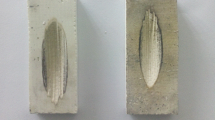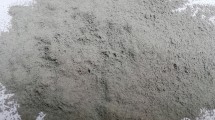Abstract
In the modern day, natural fiber-reinforced composites are becoming one of the most appealing materials for research. Vachellia farnesiana fibers were chosen for this study and extracted manually using a retting process. Chemically, the resulting fiber was treated with sodium hydroxide (NaOH) solutions and then crushed and reinforced in epoxy matrix. The hand layup procedure was used to create a composite containing 0, 3, 6 and 9% NaOH-treated Vachellia farnesiana (NVF). Two-body abrasive wear characteristics were studied for the manufactured NVF composites. Material, load (N) and sliding distance (m) were used as input factors, while coefficient of friction (COF) and specific wear rate (SWR) were analyzed as output features. ANOVA was used for evaluating the input characteristics over the output characteristics which revealed that applied load (42.70%) was the dominant factor for SWR and for COF material was the dominant factor (59.89%). The wear mechanisms were studied using worn surface morphology which revealed that the addition of fillers resulted in increased wear resistance. Finally, using the additive ratio assessment approach, the result was optimized. From the output of ARAS method, it was found that the 9 wt.% material, 20N load and 100 m sliding distance have better wear resistance.





Similar content being viewed by others
References
N. Narmadadevi, V. Velmurugan, R. Prabhakaran, and R. Venkatakrishnan, Effect of Filler Content on the Performance of Epoxy/Haritaki Powder Composite, Lect. Notes Mech. Eng., 2022, 2014, p 277–283.
D.J. Daniel and K. Panneerselvam, Processing of Polypropylene/ Spheri Glass 3000 Nanocomposites by Melt Intercalation Method, Procedia Technol., 2016, 25, p 1114–1121. https://doi.org/10.1016/j.protcy.2016.08.225
Y. Kang, X. Chen, S. Song, L. Yu, and P. Zhang, Friction and Wear Behavior of Nanosilica-Filled Epoxy Resin Composite Coatings, Appl. Surf. Sci., 2012, 258(17), p 6384–6390. https://doi.org/10.1016/j.apsusc.2012.03.046
M.S. Bhagyashekar and R.M.V.G.K. Rao, Effects of Material and Test Parameters on the Wear Behavior of Particulate Filled Composites Part 2: Cu-Epoxy and Al-Epoxy Composites, J. Reinf. Plast. Compos., 2007, 26(17), p 1769–1780.
G. Shi, M.Q. Zhang, M.Z. Rong, B. Wetzel, and K. Friedrich, Sliding Wear Behavior of Epoxy Containing Nano-Al2O3 Particles with Different Pretreatments, Wear, 2004, 256(11–12), p 1072–1081.
X. Li, Y. Gao, J. Xing, Y. Wang, and L. Fang, Wear Reduction Mechanism of Graphite and MoS2 in Epoxy Composites, Wear, 2004, 257(3–4), p 279–283.
A. Formisano, L. Boccarusso, FC. Minutolo, L. Carrino, M. Durante, and A. Langella, 2016, Wear Behaviour of Epoxy Resin Filled with Hard Powders, AIP Conf. Proc., p. 1769.
R. Vijay, J.D. James Dhilip, S. Gowtham, S. Harikrishnan, B. Chandru, M. Amarnath, and A. Khan, Characterization of Natural Cellulose Fiber from the Barks of Vachellia Farnesiana, J. Nat. Fibers, 2020 https://doi.org/10.1080/15440478.2020.1764457
V. Raghunathan, J.D.J. Dhilip, G. Subramanian, H. Narasimhan, C. Baskar, A. Murugesan, A. Khan, and A. Al Otaibi, Influence of Chemical Treatment on the Physico-Mechanical Characteristics of Natural Fibers Extracted from the Barks of Vachellia Farnesiana, J. Nat. Fibers, 2021 https://doi.org/10.1080/15440478.2021.1875353
D.J. Daniel and K. Panneerselvam, Investigation on Thermal and Tribological Properties of Polypropylene / Spheri Glass 3000 Composites Processed by Melt Intercalation Method, SILICON, 2019, 11(6), p 2885–2894.
A.G. Atkins, Toughness in Wear and Grinding, Wear, 1980, 61(1), p 183–190.
X.S. Xing and R.K.Y. Li, Wear Behavior of Epoxy Matrix Composites Filled with Uniform Sized Sub-Micron Spherical Silica Particles, Wear, 2004, 256(1–2), p 21–26.
J.M. Durand, M. Vardavoulias, and M. Jeandin, Role of Reinforcing Ceramic Particles in the Wear Behaviour of Polymer-Based Model Composites, Wear, 1995, 181–183, p 833–839.
G.Y. Lee, C.K.H. Dharan, and R.O. Ritchie, A Physically-Based Abrasive Wear Model for Composite Materials, Wear, 2002, 252(3–4), p 322–331.
K.P. Jafrey and D. Daniel, Study on Tensile Strength, Impact Strength and Analytical Model for Heat Generation in Friction Vibration Joining of Polymeric Nanocomposite Joints, Polym. Eng. Sci., 2017, 57(5), p 495–504. https://doi.org/10.1002/pen.24443
N. Liu and Z. Xu, An Overview of ARAS Method: Theory Development, Application Extension, and Future Challenge, Int. J. Intell. Syst., 2021, 36(7), p 3524–3565.
G. Karthik Pandiyan, T. Prabaharan, D. Jafrey Daniel James, and V. Sivalingam, Machinability Analysis and Optimization of Electrical Discharge Machining in AA6061-T6/15wt % SiC Composite by the Multi-Criteria Decision-Making Approach, J. Mater. Eng. Perform., 2022, 31(5), p 3741–3752. https://doi.org/10.1007/s11665-021-06511-8
V. Sihombing, Z. Nasution, M.A. Al Ihsan, M. Siregar, I.R. Munthe, V.M. Mulia Siregar, I. Fatmawati, and D.A. Asfar, Additive Ratio Assessment (ARAS) Method for Selecting English Course Branch Locations, J. Phys. Conf. Ser., 2021, 1933(1), p 1–6.
W. Österle, I. Dörfel, C. Prietzel, H. Rooch, A. Cristol-bulthé, G. Degallaix, and Y. Desplanques, A Comprehensive Microscopic Study of Third Body Formation at the Interface between a Brake Pad and Brake Disc during the Final Stage of a Pin-on-Disc Test, Wear, 2009, 267, p 781–788.
RN. Rothon, 2003 Particulate-Filled Polymer Composites Second Edition, Technology, (August), p 544, https://books.google.com/books/about/Particulate_filled_Polymer_Composites.html?id=4zFY5Yju3TQC. Accessed 17 January 2022.
K. Friedrich, S. Fakirov, and Z. Zhang, 2005 Polymer Composites: From Nano-to-Macro-Scale, Springer, p 367.
X. Hu and T. Lu, Inorganic Whiskers Reinforced Bismaleimide Composites, J. Mater. Sci., 2005, 40(7), p 1743–1748.
B. Öztürk, F. Arslan, and S. Öztürk, Hot Wear Properties of Ceramic and Basalt Fiber Reinforced Hybrid Friction Materials, Tribol. Int., 2007, 40(1), p 37–48.
S. Bahadur, The Development of Transfer Layers and Their Role in Polymer Tribology, Wear, 2000, 245(1–2), p 92–99.
C.A. Chairman, B. Thirumaran, S.P.K. Babu, and M. Ravichandran, Two-Body Abrasive Wear Behavior of Woven Basalt Fabric Reinforced Epoxy and Polyester Composites, Mater. Res. Express, 2020, 7(3), p 035307.
R. Bassani, G. Levita, M. Meozzi, and G. Palla, Friction and Wear of Epoxy Resin on Inox Steel: Remarks on the Influence of Velocity Load and Induced Thermal State, Wear, 2001, 247(2), p 125–132.
Author information
Authors and Affiliations
Corresponding author
Additional information
Publisher's Note
Springer Nature remains neutral with regard to jurisdictional claims in published maps and institutional affiliations.
Rights and permissions
About this article
Cite this article
Albert, F.A., Jafrey, D.J.D., Karthik Pandiyan, G. et al. Tribological Studies and Optimization of Two-Body Abrasive Wear of NaOH-Treated Vachellia Farnesiana Fiber by Additive Ratio Assessment Method. J. of Materi Eng and Perform 32, 82–90 (2023). https://doi.org/10.1007/s11665-022-07082-y
Received:
Revised:
Accepted:
Published:
Issue Date:
DOI: https://doi.org/10.1007/s11665-022-07082-y




